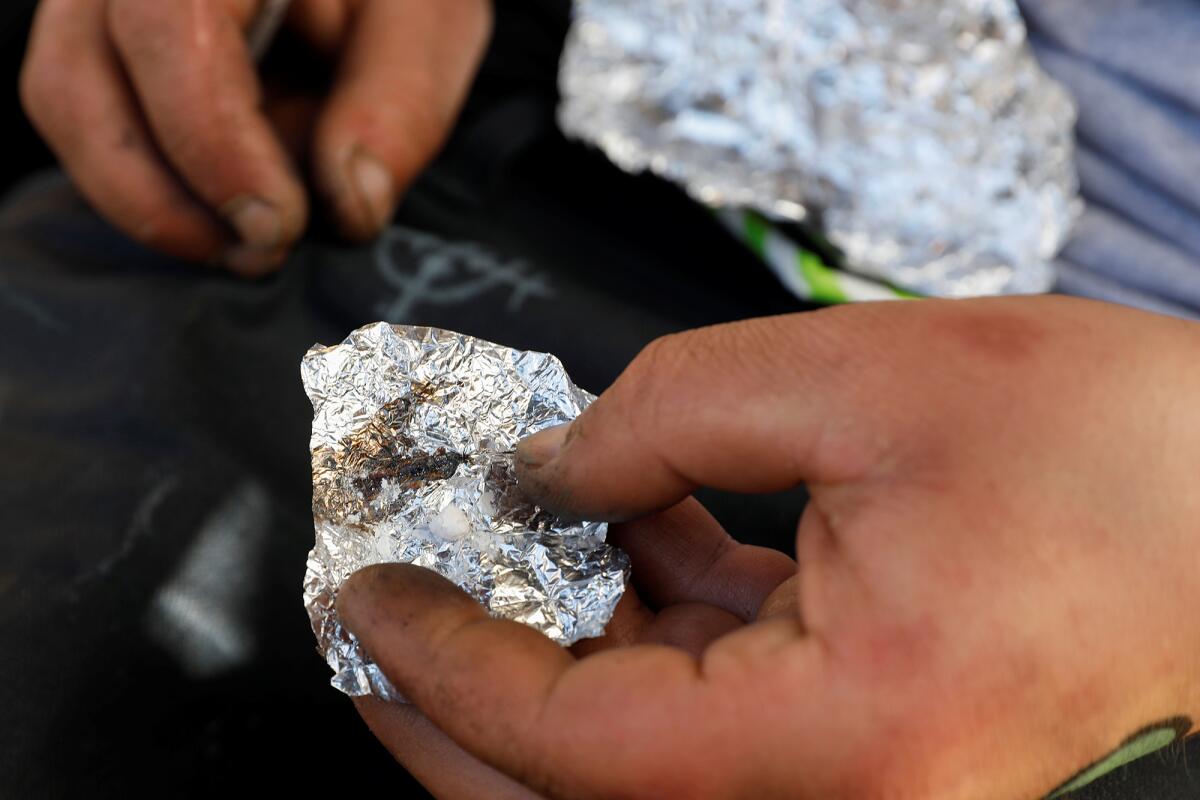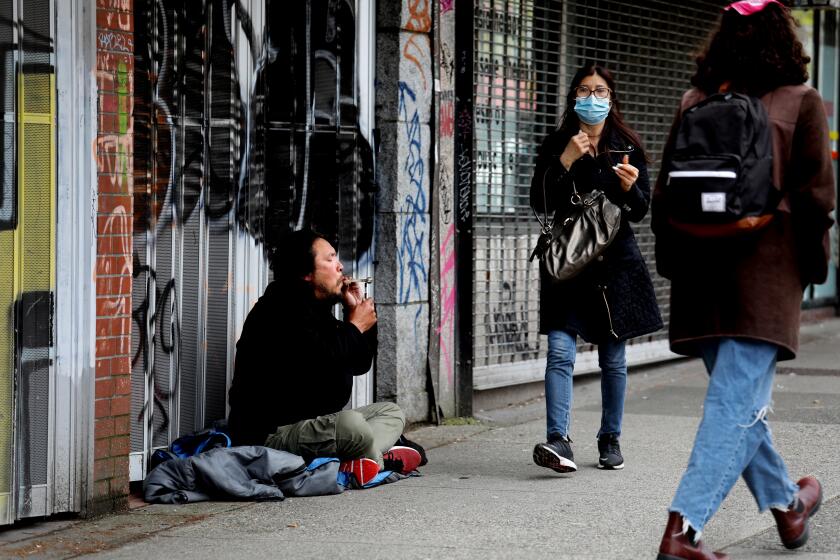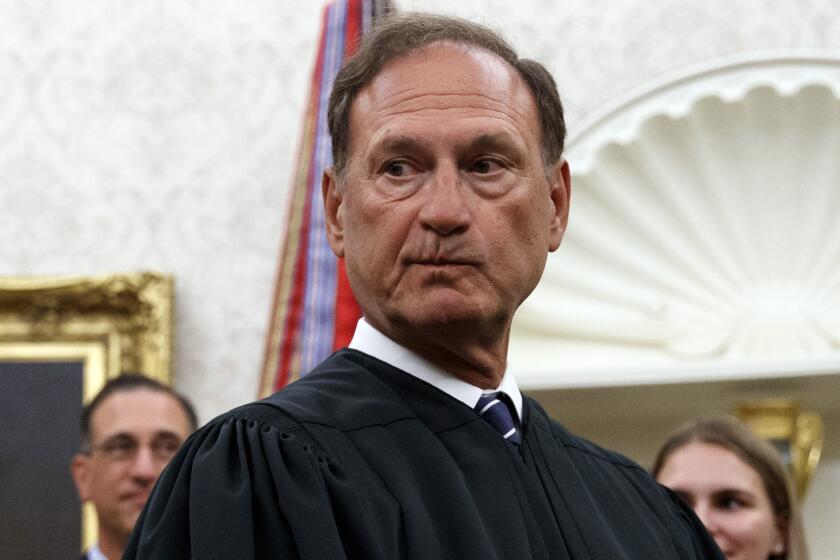Column: Kids are dying from fentanyl. More prison time for dealers won’t help

- Share via
SACRAMENTO — For weeks, there has been an uproar in the California Legislature about fentanyl.
Republican lawmakers, though few in number, have led a surprisingly successful revolt around a handful of bills that largely focus on increasing criminal penalties for dealing the synthetic opioid. They have managed to push some of these measures forward despite the efforts of progressive Democrats to focus on a non-punitive public health response.
More shocking, despite years of criminal justice reform and an unambiguous understanding of how ramped up sentencing led to over-incarceration of Black and brown people during the crack epidemic, some Democrats are warming up to those Republican proposals because they sound effective and make voters feel like something is being done. It’s a rare bit of alignment between moderate Democrats and Republicans in a Legislature increasingly skewing left of left and where there is little upside in crossing party lines.
This might seem like a good thing, a way to argue our way to the best middle ground in a state where nearly 6,000 people died from fentanyl overdoses in 2021, about 16 people per day on average. Nationally, 107,000 people died of overdoses or accidental poisoning last year — one every five minutes.
But efforts to frame this debate as a battle of the so-called softie harm reductionists — think passing out meth pipes on Skid Row — against the practical law-and-order types is a waste of time and lives. On May 24, the Legislature will hold a mega-hearing to air these two views. But the reality is neither of those approaches will work on their own, and no combination will either. We need a new starting point and a new way of thinking.
This can’t be another war on drugs.
It needs to be a war on addiction. A war not on the supply — and suppliers — of fentanyl, but on the demand for it.
“It’s just really clear now from 50 years of trying to stop the supply, it doesn’t work,” Dr. David Goodman-Meza, an infectious disease doctor at the UCLA David Geffen School of Medicine, told me. Goodman-Meza recently testified at a contentious Capitol hearing, and is piloting a mobile pharmacy in Los Angeles to bring addiction treatment to the places people need it most.
“Cartels want to bring drugs because we have a massive demand for them,” he points out.
To understand why neither arrests nor needle exchanges will ever stop opioid overdoses, you need to know several things about why this drug epidemic is different from crack or heroin or anything that has come before.
First, there are two fentanyl crises: the urban street catastrophe; and the suburban nightmare. Street users often come from lives of trauma and poverty, using illegal drugs to compensate for mental illness or the upheavals of instability. By the time they are living unsheltered, increasingly in once-quiet residential neighborhoods, the answers to their addictions are complex. But society’s perception of them often is not. They are seen as complicit in their decline, petty criminals and a public nuisance.
We tend to think of suburban users without that stigma — kids experimenting or using recreationally, as young people have always done, but now with higher stakes.
It is terrifying to every parent, myself included, that the web is an open marketplace for fentanyl-laced pills — the first drug epidemic of the digital age. Young people are dying at alarming numbers, and the story is too often the same: a mom or dad checking on a child only to find them cold and lifeless.
This suburban crisis is fueling a narrative of fentanyl as a weapon of mass destruction, aimed at naive victims who don’t know the fake pills contain poison. Until the fatality, many parents have said they had no idea their child was using.
It is the justifiable pain and outrage of those families that has ignited demand for stiffer penalties, similar to the calls from suburban crime victims in the 1990s that led to three-strikes laws enacted in the wake of the Northern California murder of Polly Klaas. These families have a desire to turn grief into accountability so that others don’t suffer the same fate.
“The punitive measures make intuitive sense to a lot of people,” Assemblymember Matt Haney told me. He rents an apartment in San Francisco’s Tenderloin and represents the area, which is a ground zero for drug problems and has become a national symbol for conservatives on what they consider failed harm-reduction policies.
“The idea that if we just pulled off the drug dealer from the corner, that everything would go away, is an attractive concept,” Haney said.
The far-right loves to paint San Francisco as a crime-ridden ‘hellhole.’ The celebration of an iconic transgender club is a reminder of what the city is really about.
But our existing laws already lock dealers up for decades. In 2020, a Contra Costa mother was charged with murder in the fentanyl death of her toddler, not because she meant to kill him, but because prosecutors argued she should have known the fentanyl she possessed could be fatal.
Since then, it’s become common for prosecutors to bring serious felony charges in illegal opioid cases based on that same argument. Riverside County since 2021 has filed about 20 second-degree murder cases against dealers, according to Dist. Atty. Mike Hestrin. Those kinds of cases, which carry harsher penalties than traditional drug charges and often are loaded with the extra penalties of “enhancements,” have even been levied against teenage dealers.
Adding more years to prison sentences through more enhancements, as Republicans are calling for, will do just what it did during the crack epidemic: fill prisons with the lowest levels of disposable dealers without impacting the larger drug trade.
“The typical street corner dealer is not well-educated, doesn’t make much more money than a fast food worker,” Keith Humphreys told me. Now a Stanford professor, Humphreys advised both the George W. Bush and Obama administrations on drug policy.
“Whether you put [dealers] away for one year or five years, it doesn’t make much of a difference.”
None of that is to argue we shouldn’t enforce the laws we have, he said, nor should dealing go unchecked.
But Goodman-Meza and Humphreys agree that enforcement alone will never stop the fentanyl epidemic because it focuses on supply. Historically, we frame drug crises as driven by dealers — from El Chapo to the guy on the corner with a Ziploc bag. If we can disrupt the trafficking, arrest the traffickers, we stop the drugs from reaching the users and we win.
That may have had some truth in the days of poppy and coca fields, when crops took time to grow and confiscated shipments were harder to replace. But “kilo chasing” doesn’t work with fentanyl, Humphreys said, because it is easy to make it anywhere, and so powerful that a little bit can be cut into huge profits.
Take as much as you want off the street, and dealers will have a new supply faster than the haul can be booked into evidence. It’s like scooping water out of a river with a teaspoon.
And the recipe for street fentanyl is morphing into more potent combinations — including the upsurge in fentanyl mixed with the animal tranquiler xylazine, which prolongs the high but makes overdoses harder to reverse.
That’s another thing we need to understand about this epidemic: Fentanyl is not a secret poison hidden in illegal drugs by unscrupulous dealers. Fentanyl is the drug an increasing number of users want precisely because it is stronger than heroin or meth.
“They know they are using fentanyl,” said Goodman-Meza.
Legislators love to wave around sugar packets claiming a few grains of fentanyl is enough to kill. And for an inexperienced teenager who doesn’t have a tolerance, that might be true. But it is equally true that dealers are giving buyers what they want — a high that is longer, stronger and cheaper than what was available last week, so enslaving even the threat of death isn’t a deterrent.
The only real way to battle that limitless and evolving inventory is to decrease demand. Which brings us to the last thing you need to know: Treatment works.
For the first time in a drug epidemic, we have multiple options for medication-assisted treatment, the ability to fill those brain receptors with safe pharmaceutical replacements such as methadone and buprenorphine so that the physiological and psychological cravings for opioids can be stunted. Medication-assisted treatment isn’t a magic bullet. For many people it’s a form of maintenance — a way of living with addiction. Sadly, one of the best places to get the treatment is in our prisons, where more than 16,000 people are receiving it.
Until recently, the federal regulations on these replacement drugs made it hard for doctors to offer them. The Biden administration removed those cumbersome rules, but most doctors still don’t want to get involved in addiction treatment for a variety of reasons. The low Medicaid reimbursements are a big part of this problem, because as Goodman-Meza puts it, doctors will only do what they have to do, or what they are paid to do.
So medication-assisted treatment remains scarce, with only about 20% of those with substance use problems accessing any treatment, and fewer than that receiving medication, according to Goodman-Meza. In his revised budget plan released Friday, Gov. Gavin Newsom suggested funding more enforcement and putting $251 million toward expanding access to the overdose drug naloxone — but only $10 million toward education and recovery.
The underlying reason for the scarcity remains stigma: our collective, if not overtly stated, belief that addiction is a weakness rather than a chronic disease, and relapses — or replacements — are moral failures. Those who treat addiction know abstinence may be a goal but not a reality for many. Treatment involves a lifetime of work, and possibly medication, just as it does for diabetes, heart disease or depression.
“That is the most effective way we know to help you keep your housing, help you keep your finances, help you keep your human relationships,” Goodman-Meza said of medication-assisted treatment.
For years, this Canadian city has hosted safe consumption sites for addicts. They’ve saved lives, but with some painful tradeoffs.
The stability that effective treatment can bring is also good for public safety. In reality, it’s the crimes that stem from addiction that plague society, not the addiction itself. Plenty of wealthy folks have addictions behind the doors of their homes, with the financial resources to hide it.
It’s poor people with addictions, who live on the streets, defecate on the streets, inject on the streets, and possibly steal or commit crimes to support their habit that frighten and offend us and drag neighborhoods into chaos. Take away the need to pay for illegal drugs, and you decrease crime and homelessness.
So a commitment to universal treatment, on demand, wherever users are, should be at the center of our policies — a public health offensive on par with how we ultimately responded to COVID-19 or AIDS — because it helps both individuals and communities.
But don’t confuse a war on addiction with a war on people with substance use disorders. Our starting point can’t be judgment or ultimatums.
That shift in focus requires us to see street users as worthy of help and suburban pill purchasers as drug users in need of intervention — both uncomfortable positions for some.
But “a death is a death,” Assemblymember Reggie Jones-Sawyer, a Los Angeles Democrat, told me, whether the life is lost in minutes in a high schooler’s bedroom, or slowly extinguished after years of homelessness. Somebody, somewhere, loved that person. Somebody feels the grief.
Jones-Sawyer is the chair of the public safety committee where much of the fighting over fentanyl has taken place. During the crack epidemic, he worked as the night manager in a mortuary in South Los Angeles. He saw firsthand what the criminalization of that drug did both to individuals and neighborhoods in the often neglected section of the city, and is adamant we don’t repeat that history.
If we can get beyond our false divides, we don’t have to.
Let law enforcement use existing laws to dismantle the big players and protect vulnerable neighborhoods. Let harm reductionists use every tool they can — from supplies to safe consumption sites — to save lives in the short term. Then move the conversation, and the fight, to the bigger picture: building a system of addiction treatment that reduces the demand for illegal drugs.
Because ultimately we all want the same result: for our loved ones to survive whatever the cartels throw at us next.
Sign up for Essential California
The most important California stories and recommendations in your inbox every morning.
You may occasionally receive promotional content from the Los Angeles Times.










